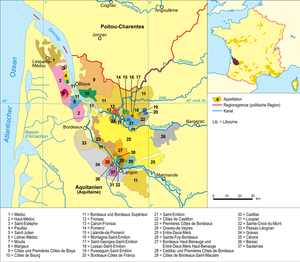Saint-Emilion (AOC)
The Saint-Émilion (AOC) wine-growing region is one of the best known and most famous in southwest France. Within the Bordelais wine-growing region , Saint-Émilion - together with Pomerol - forms the core area of the “right bank” of the Gironde and Dordogne ; also called Libournais after the city of Libourne .
history
Wine was already being grown in the area around the city of Saint-Emilion during the time of Roman rule . Even the poet Ausonius , after whom Château Ausone is named, worked there as a winemaker. The city itself in its current location and shape was founded in the 8th century by a hermit of the same name. Saint-Emilion was an important stage for pilgrims on the Camino de Santiago to Santiago de Compostela . Today around 5,700 hectares are planted with vines in the Saint-Émilion region, which are distributed among around 1,000 winegrowers.
Viticulture
The red wine from Saint-Émilion has its own appellation , which also includes some neighboring communities. Together with Pomerol , Saint-Émilion forms the core area of the "right bank" of the Gironde and Dordogne ; also called Libournais after the city of Libourne , meanwhile the Médoc peninsula and the Graves region mark the "left bank".
In addition to the two aforementioned appellations, the satellite appellations Lalande-de-Pomerol , Montagne-Saint-Émilion , Puisseguin-Saint-Émilion , Lussac-Saint-Émilion and Saint-Georges-Saint-Émilion as well as Fronsac and Canon-Fronsac belong to the Libournais .
As is usual on the “right bank”, the Merlot grape variety also predominates in the cuvées of Saint-Émilion . Only a few goods on the plateau on the border with Pomerol, such as Château Figeac and Château Cheval Blanc , predominantly use Cabernet Sauvignon and Cabernet Franc .
Appellations of Saint-Emilion
As a specialty, there are even two communal appellations in Saint-Émilion: Saint-Émilion and Saint-Émilion Grand Cru . For the last-mentioned appellation, the wines must undergo a second, more demanding quality test before bottling. However, the trend is clearly in the direction of the production of Grand Crus: In the problematic 2002 vintage, 134,850 hl of wine were declared as Grand Cru and only 82,750 hl as Saint-Émilion. In 1990 the ratio of 156,600 hl Grand Cru to 137,200 hl Saint-Émilion was still almost balanced, although the quality of the vintage was very high.
Classification and specifics
The best Grands Crus enjoy the special status of classified plants, with another distinction being made between Grand Cru Classé and Premier Grand Cru Classé. The classification of Saint-Émilion is revised approximately every ten years, in the years with a four at the end, the positioning of the wineries is determined, which then usually become effective in the years with a 6. Since the classification was only introduced in 1955, there have been revisions in 1969, 1985, 1996 and 2006. The 2006 classification was suspended on March 30, 2007 by administrative act. It finally came into force in November 2007 by government decree. The last update to date followed in 2012.
The goods must always apply for classification. The quality of the last ten years is assessed . In addition, there are criteria such as the reputation of the wine with critics and trade, the market price achieved and the quality of the terroir . In contrast to the Médoc, the classification is therefore also linked to the locations themselves. In 1986, for example, Château Beau-Séjour Bécot was withdrawn from Premier status for ten years after the winery had expanded its vineyard area by purchasing lots. The Château Canon-La Gaffelière owned by Count Stephan von Neipperg had similar problems . The high-quality vineyards of the La Mondotte estate, which is owned by the same company, were not allowed to be included in the Grand Cru Classé. La Mondotte was therefore prepared separately and, even as a “ garage wine ”, achieved higher prices than many “premiers”. In 2012 he moved up to the rank of Premier Cru Classé.
The following is the 2012 classification. It should be noted that the producers that are no longer or differently classified keep their classification for the previous vintages: A 2008 Château Magdelaine remains a Premier Grand Cru Classé B, although the estate is no longer listed as a Grand Cru producer in 2012.
Four outstanding goods are classified as Premier Cru Classé A, there are also a further 14 Premier Grand Cru Classés (B) and 64 Grand Cru Classés, in 2006 there were only 46. Newcomers compared to 2006 are marked with *.
Premier grands crus classés A 2012
Premier grands crus classés B 2012
|
Grands Crus Classés 2012
In 2006, compared to 1996, the Châteaux Bellevue , Cadet-Bon , Faurie de Souchard , Guadet Saint-Julien , La Marzelle , Petit-Faurie-de-Soutard , Tertre Daugay , both La Tour du Pin-Figeac (Giraud-Belivier and Moueix) were outclassed , Villemaurine and Yon-Figeac .
In addition, Château La Clusière became part of Château Pavie, and Château Curé Bon La Madeleine is now part of Château Canon.
Web links
- The wines of Saint-Émilion (French)
Individual evidence
- ↑ Denis Saverot: L'absurdité d'une décision . In: La Revue du Vin de France . No. 511, May 2007, ISSN 1634-7625 , p. 3
- ↑ Press release of the Conseil des Vins de Saint-Émilion (French) ( Memento of October 31, 2008 in the Internet Archive )
- ^ Official classification of the wines of Saint-Émilion 2006 (PDF) ( Memento of April 22, 2007 in the Internet Archive )



